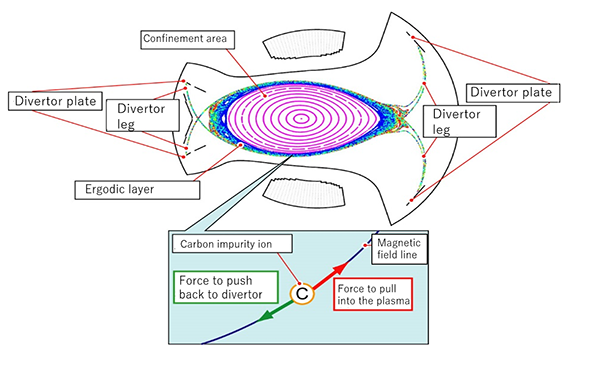HOME > Research Activities > Research Updates >
In the Large Helical Device (LHD), a doughnut-shaped container is produced by magnetic field lines, and high-temperature plasma is confined. Inside the confined plasma, the ions of carbon and oxygen, and of metals are included. These are called “impurities.” Impurity ions absorb energy from a plasma and emit the energy as light. Because this lowers the plasma temperature, in order to maintain the high temperature inside the magnetic field lines container, it is necessary to reduce the impurities. Actually, the LHD is a device appropriate for producing plasmas bearing few impurities. This is because a phenomenon called “impurity screening” occurs, in which it becomes difficult for impurity ions to enter the plasma. Here, we will introduce recent observation results relating to impurity screening.
How are impurities screened? We will explain this using carbon ion impurities, which are dominant in the LHD, as an example. At the last closed surface of the LHD’s magnetic field lines container are magnetic field lines of various lengths long and short that are folded one upon another. These are found in the area called the “ergodic layer,” which is in the shape of complicated magnetic field lines. These magnetic field lines, in the end, are led to the divertor plate, which absorbs heat. The divertor plate is placed in an area distant from the plasma. The plasma particles that moved from inside the container by following the magnetic field lines strike the divertor plate, and the carbon atoms are sputtered. The carbon atoms ionize and become carbon ions, and while moving around as if coiled around the magnetic field lines they move toward the ergodic layer. At the ergodic layer are plasma temperature and density gradients which are along the magnetic field lines, and forces are added to the carbon ions due to those gradients. Here, if the force which pushes the carbon ions back to the divertor plate is stronger than the force which draws the carbon ions in the plasma, a “flow” of carbon ions toward the divertor plate is generated, and intrusion into the plasma is prevented. That is, it is thought that the flow of impurity ions inside the ergodic layer brings about impurity screening.
In order to confirm through experiment whether this view is appropriate, the most direct method is to measure whether there is a flow of impurity ions in the ergodic layer. Helpful here is the “spectroscopy” method in which the light emitted from the plasma is separated at each wavelength. The impurity ions inside the plasma emit light of differing wavelengths depending upon the ion species. This is called the “line spectrum” of impurity ions. By examining the wavelength and the light intensity of this line spectrum, we learn the species and the quantities of impurity ions. Thus, in the LHD we have advanced in preparing a spectroscopy system that observes “vacuum-ultraviolet light” (a shorter wavelength than the “visible light” that humans can see) emitted from the plasma with high spatial-resolution. Now, using this system, when we increase the electron density in a plasma we measure the changes in the line spectrum of carbon ions. As a result, the shift of the center of the carbon ion line spectrum to the shorter wavelength was observed. This wavelength shift is due to the “Doppler Effect,” which indicates that there is a flow of the carbon ions, and that flow approaches in the direction of the observer (diagnostics device). When we compared the experimental results with the numerical simulations based upon theory, the impurity ions were pushed from the plasma in the direction of the divertor plate. That is, we learned that the impurity ions were in the direction which screens the ions. Further, based upon measurement, by increasing the electron density in the plasma, we also learned that there is a tendency for the speed of the flow to become large. This, too, matched well with the simulation result. The increase in the flow speed was caused by the growing force to ions resulting from the density gradient increasing due to the increase in the electron density. That is, in these measurements, the idea that “force works in impurities” and “flow is driven” has been verified for the first time in experiment. In the future, through these types of measurements we will advance in our research on control methods for impurities where impurity ions will be effectively screened, and halt outside the magnetic field lines container.

Sectional view of the LHD vacuum vessel and the structure of magnetic field lines. In the magnetic field lines container, the “plasma confinement region,” where plasma is confined, the nearby “ergodic layer,” and the “divertor leg” which connects the ergodic layer with the “divertor plate” are the principal items. In the ergodic layer, the direction of the force on impurity ions is along the magnetic field line, and the “flow” of impurities is driven.

Image 2:
Vacuum ultraviolet light spectrum of C3+. The wavelength shift of line spectrum shows that carbon impurity ions flow and the flow velocity toward the instruments is six kilometers per second.
